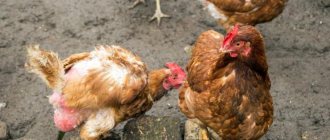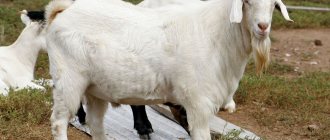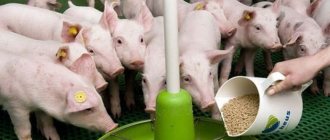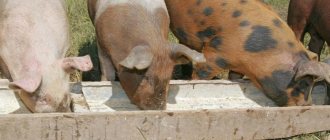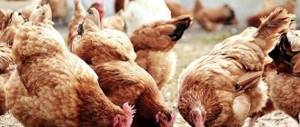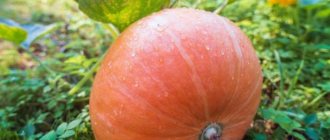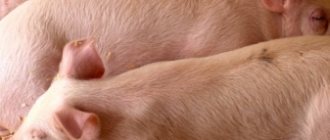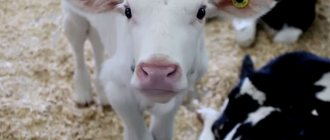How important is a high-quality feed supply and what does it consist of?
The feed supply of dairy cattle plays a key role in the process of milk production and directly affects the productivity of cattle, and therefore the economics of the farm. The results of milk production are 50% determined by well-designed diets, and feeding costs account for up to 60–70% of the production cost structure.
The feed base includes forage, protein, fats, energy components, amino acids, vitamins and minerals.
Cereals
Cereals.
Sorghum
. This grain is much smaller than corn, and some of it passes through the digestive tract of animals unused. To avoid this, it is advisable to subject sorghum grain to special processing. In pastoral areas where this particular feed is most common as an energy source, processing is mainly used to produce flakes. If this treatment is carried out properly, the feed value of sorghum flakes is comparable to that of cracked corn. However, in cases where the cost of equipment for making flakes is very high, grinding sorghum grain may be recommended to obtain high-quality feed.
For grain processing
Other methods described in the section on corn processing are also suitable for sorghum. However, the flake manufacturing method is preferred.
Wheat.
Wheat is generally more expensive than most other cereal grains, so it is rarely used as cattle feed. However, if its cost is comparable to the cost of other types of grain, then wheat can be successfully included in the diet of livestock. Most varieties of wheat contain 10-12% protein, which must be taken into account when formulating diets.
Animals readily eat wheat, but when fed as the only grain feed, various metabolic disorders, such as acidosis, can occur. To avoid this, it is recommended that wheat make up no more than 50% of the total grains in the diet.
Wheat can be used as the sole grain feed only in diets containing a large amount of bulk feed. Wheat grain can be processed in a variety of ways, as described in the section on corn. However, nowadays wheat is most often used in crushed form.
Barley.
Barley is used as grain feed in areas where it is the predominant grain crop. Due to its high fiber content (approximately 6%), when it is included in the diets of fattening cattle, there is no need to introduce large amounts of roughage into them. In terms of its feed value, barley is quite comparable to corn. When barley is included in the diets of fattening cattle along with alfalfa hay, the risk of tympania in animals increases, especially if the barley is not dried well enough after harvesting.
Oats
. Compared to barley, oats contain more crude fiber (about 10%) and the same amount of protein. Due to the high fiber content of oats, animals on a high-concentrate diet do not eat as much of it as corn (by weight).
Oats are an excellent feed for growing calves and breeding stock. If the market price situation is favorable, then oats can be used as a complete substitute for all other grains. Due to the fact that their protein content is higher than other cereals, less protein supplement can be included in a diet containing oats.
Rye
. Rye has some properties that make it less suitable for inclusion in cattle diets than other cereal grains. The specific smell of rye causes a decrease in its consumption by animals, and, consequently, worsens the productivity of animals. However, rye can be fed in combination with other feeds, but it is recommended to limit its content to 50% of the total amount of all grains in the diet. Even at this level, animals may not eat food well if they are not gradually accustomed to consuming rye in small portions.
Rye is sometimes affected by ergot. If such grain is bought on the market, then it must be fed with great care. To prevent digestive disorders and various complications, the level of such grain in the diet should not exceed 10%.
Triticale
. This cereal is a hybrid of wheat and rye. Therefore, it has many of the properties of rye. Animals do not eat it very readily. To obtain maximum efficiency, triticale grain should be mixed with other cereal feeds. Triticale is also affected by ergot. Therefore, it should be fed with caution.
Squirrels
The source of protein can be meat meal without blood, meat meal with blood, meat and bone meal, fish meal, blood meal. All these foods have a high protein content, including non-degradable protein.
| Crude protein, % | Unbreakable protein, % | Methionine, % of protein | Lysine, % of protein | |
| Meat meal without blood | 85 | 7,4 | 2,6 | 0,7 |
| Meat meal with blood | 86,9 | 10 | 2,9 | 0,8 |
| Fish flour | 63,27 | 21 | 6,83 | 2,53 |
| Meat and bone meal | 50,01 | 16,09 | 4,58 | 1,25 |
| Blood meal | 95 | 17 | 8,77 | 1,15 |
The technology for the production of meat and bone meal involves heat treatment of non-food raw materials under conditions that ensure their dehydration and degreasing. As a result, another product is formed - technical fat.
Fishmeal is produced by drying and grinding waste from fish processing, as well as from residues from the cutting of marine mammals and seafood. Usually this is anchovy, pollock, flounder, herring, mackerel, sardine, meat of whales, pinnipeds and crustaceans. Flour with a fat mass fraction of more than 8% necessarily contains stabilizing additives of the antioxidant ethoxyquin.
There are two ways to prepare blood meal: high- and low-temperature. According to the first method, blood meal is prepared by coagulating blood with superheated steam, followed by pressing, drying and grinding. The blood meal produced by this method does not dissolve in water. The second method is to dry the blood in vacuum evaporation units at a temperature of 55 °C; this blood meal dissolves well in water. In terms of feeding qualities, blood meal dried at low temperatures is much better than that obtained by high-temperature processing.
Plant protein
After analyzing the American feed supply, experts identified the main sources of vegetable protein for cows. They can be the following components:
- malted barley sprouts (a by-product of beer production),
- dry and wet brewer's grains (a by-product of beer production),
- rapeseed meal, as well as rapeseed meal treated with xylose to protect protein from destruction in the rumen,
- corn gluten, distilled corn (ethanol production waste),
- cotton seed meal,
- flax meal,
- lupine,
- peas,
- peanut meal,
- sunflower meal,
- extruded soybean, fried, meal,
- post-alcohol stillage,
- syrup from condensed distillate.
Most sources of plant protein are waste from oil production (sunflower, soybeans, canola, cotton, flax, peanuts), as well as by-products of beer and alcohol production. Many farms that grow their own legumes can process them themselves and feed them to animals. Thus, roasted soybeans have high levels of protein and fat. Peas, lupines and grains can also be processed to improve the taste and nutritional properties of the feed. However, when using lupine, you should be careful and choose low-alkaloid varieties, that is, the so-called white lupine.
Manufacturers often try to supplement the diet with proteins using special additives. Protein supplements are based on roasted soy with increased levels of bypass protein or a mixture of fish meal, blood meal and/or dry yeast. But before you look for an expensive magic protein, you should think about what plant sources are available on the farm, how they can be effectively processed, and then see where you can buy production waste nearby.
Concentrated feed
Concentrated feeds include grain feeds and by-products of processing grain and oilseeds; such feeds are highly nutritious and contain up to 16% water and up to 15% fiber, they are digested within 70-90%. The total nutritional value of concentrated feed is 0.7-1.3 feed. units in 1 kg.
Depending on the content of digestible protein and carbohydrates, concentrated feeds are divided into two groups: protein feeds, containing 20-25% protein (pea seeds, soybeans, beans, etc., cakes and meal) and carbohydrate feeds, which contain 60-70% starch ( grains of oats, barley, corn, wheat, millet, etc.). Concentrated feeds serve as an indispensable part of diets for animals and poultry. However, they lack essential amino acids in nutrition - lysine, methionine and tryptophan. In addition, concentrated feed contains almost no carotene, vitamin D, and is poor in calcium and microelements. When feeding them to animals, especially pigs and poultry, special protein supplements are constantly required, as well as the inclusion of minerals and vitamins in the diet.
Of the grain cereal feeds, barley is most widely used in feeding animals, especially pigs. 1 kg of it contains on average 1.15 units, 113 g of crude protein, 485 g of starch, 49 g of fiber. In the diet of pigs, barley can account for up to 70% of the total nutritional value.
The most nutritious grain feed is corn. 1 kg of corn contains 1.2-1.3 feed. units, 69-72 g of digestible protein, 0.7 g of calcium, 2.5 g of phosphorus. However, corn protein is poor in lysine, methionine, and tryptophan. It should be noted that ground corn quickly deteriorates (it gets warm, goes rancid) and even at a humidity of 12%, it is not recommended to store it for more than 2 months.
Wheat that is unsuitable for food purposes is also used as feed grain. Its nutritional value is 1.2-1.3 units. In terms of protein content, it surpasses all other grains. 1 kg of it contains 133 g of crude protein, but compared to barley there is less calcium and lysine. Wheat is added to feed for pigs in an amount of 20-30%.
Oat and rye grains are also used in feeding farm animals. A special feature of oats is their high fiber content - 97 g per 1 kg, which is twice as much as barley. Protein in oats is 9-12%, but it is deficient in methionine, histidine and tryptophan. Oat fat (about 4-5%), rich in unsaturated fatty acids, negatively affects the quality of meat and lard. Horses are given up to 10 kg per head per day. For young animals, decoctions, porridges, and jelly are prepared from oats. In terms of dietary properties, oats are one of the best grain feeds and are successfully used in feeding breeding animals and producers. Rye's chemical composition is almost no different from barley, but is poorer in nitrogen-free extractives. Rye starch swells greatly in the stomach of horses, which often leads to digestive disorders and colic. With large amounts of rye milk fed to cows, the quality of milk deteriorates.
Among the by-products of flour milling production, bran occupies the first place. They consist of worn-out grain shells with a certain amount of mealy substance. In terms of overall nutritional value, bran is inferior to grain, but is richer in protein, fat, minerals and B complex vitamins. Bran can be wheat, rye, oat, barley, etc. Wheat bran is especially valuable for dairy cows and growing young animals.
Legume grains play an important role in the group of concentrated feeds. Peas occupy the leading place among legumes on Belarusian farms. 1 kg of its grain contains 1.19 units, 195 g of digestible protein, 54 g of fiber. Pea protein is the most complete of grain crops. The inclusion of peas in animal diets increases productivity and has a positive effect on product quality (the composition of milk, the quality of meat and lard are improved.
Lupine
- a valuable high-protein crop. Nutritional content of 1 kg of lupine 1.1 units. and 270 g of digestible protein. In this regard, among other legumes in the conditions of Belarus, lupine has no equal. However, its grain contains alkaloids - lupinine and sparteine, which cause digestive upsets and give milk and butter a bitter taste. Therefore, non-alkaloid or low-alkaloid varieties of lupine should be used in animal feeding; sometimes bitter lupine grains are used after soaking in cold water, the bitterness disappears.
Preparation for feeding grain feed. When whole grain is used in animal feeding, its loss is 10-20%. To reduce losses, grain is subjected to grinding, roasting, steaming, malting, germination, yeasting, micronization, and extrusion.
Grinding is a mandatory technique when processing cereal grains and legumes. By grinding, crushing and flattening grain, the hard shell is destroyed, which makes chewing easier, resulting in increased availability of nutrients and, consequently, reduced feed consumption per unit of livestock production.
The crushed grain mixes well with other feeds. The degree of grinding depends on the type and age of the animals. Pigs and early calves use finely ground grain (about 1 mm) better. For adult cattle, the particle size should be 1.5-2 mm.
Crushed grain is fed to animals of all types in a mixture with chopped root vegetables, silage, and straw cuttings.
During processing, part of the starch breaks down into monosaccharides, which makes the grain taste sweet, but due to protein denaturation, protein digestibility and the availability of amino acids are somewhat reduced. High temperature has a detrimental effect on bacterial contamination and various types of fungi in grain, which makes it possible to largely avoid diseases of the gastrointestinal tract of piglets.
Barley, wheat, corn, and pea grains are roasted until light brown or brown. It is fed to piglets from 5-7 days of age until weaning, starting with small doses (30-50 g), gradually increasing the daily rate to 120-150 g.
Steaming and cooking of peas, soybeans, lentils, lupine and other grains and legumes is carried out whole or crushed in a feed steamer for 30-40 minutes. After processing, legume grains are mixed with other grain feeds or chopped root vegetables and given to pigs in an amount of 20-30% of the total nutritional value of the diet.
Malting
used to improve the taste of grain feed (barley, corn, wheat, etc.) and increase their palatability, since during processing, part of the starch under the influence of diastase of grain or malt turns into sugar, which improves its digestibility. This feed is fed to suckling piglets, weanlings and fattening pigs (50% of the total amount of concentrates in the diet).
Yeasting
- an effective way to increase protein in animal diets. In this case, the grain is enriched with protein (its content increases by 1.5-2 times), which has a high biological value, contains all the essential amino acids and is absorbed by the animal body by 90-95%. Yeasting allows you to save up to 25% of concentrated feed. Feeding yeast concentrates has a beneficial effect on animal health and increases their productivity by 15-20%.
Extrusion
- one of the most effective methods of grain processing, which leads to significant transformations in the structure of its nutrients, changes in the physical and chemical properties of protein, starch, fiber, while the sanitary condition of the feed is significantly improved,
Extrusion is based on the processes of mechanical action (compression, friction) that occur when grain passes through a pre-extruder and “explodes” as a result of a sharp transition from a high pressure zone to an atmospheric one, i.e. at the moment of ejection of a homogeneous mass from the machine.
Thanks to extrusion, the biological value of legume grain protein increases, starch and cellulolignin complexes are partially destroyed, starch molecules are converted into dextrins, the amount of sugars increases, the nutrients of grain feeds become more accessible for absorption by animals, and most of the microflora is destroyed.
The processed grain has the smell of baked bread and a pleasant taste. Its inclusion in feed or feed mixtures leads to increased animal productivity. The effectiveness of using such feeds is especially high when feeding young farm animals, and primarily pigs.
Micronization
grain causes a significant (up to 98%) breakdown of starch to sugars, the amount of alkali-soluble proteins increases by 3-5%, which contributes to their better digestibility and assimilation by the animal body.
The essence of the method is that infrared rays (wavelength 2-6 microns), penetrating into the grain, cause intense vibration of starch molecules. After micronization, it must be flattened and cooled, otherwise it may quickly return to its previous state. The introduction of crushed micronized grain into feed increases the average daily growth of pigs by 11-12%.
Moisture-thermal processing of grain with flattening makes it possible to increase the nutritional value of the resulting product at an optimal level of labor and energy costs for preparing feed; methods for complex processing of grain with heat, moisture and mechanical action deserve attention. The most effective mechanical technique is passing wet grain through conditioner rollers to produce flakes. Rolled grain is successfully used in cattle diets, as well as in raising pigs and poultry.
Flaxseed meal contains less protein, but it has a beneficial effect on digestion. A decoction prepared from flaxseed is a dietary remedy for diarrhea. Flaxseed cake or meal has the ability to absorb large amounts of water and swell in it to form mucus. Mucus envelops the walls of the stomach and intestines, protects them from irritation, prevents constipation, but does not have a strong laxative effect even in cases where cake and meal are fed in large quantities. Therefore, they are very useful primarily for young animals. Adult animals, such as cows, quickly respond to feeding flaxseed meal by increasing their milk yield, their coat becomes shiny and shiny.
At the same time, when using flaxseed meal, certain precautions must be taken to prevent poisoning of animals with the harmful glucosides they contain. To prevent poisoning, it is recommended to boil flaxseed cakes and feed them chilled.
Sunflower cake and meal are close in nutritional value to flaxseed. Their nutritional value largely depends on the husk content (it should be no more than 14%). They are fed to cows up to 4 kg, to pigs - 2-3 kg.
Cotton meal is rich in protein, but it must be fed carefully, as it contains the toxic substance gossypol. This poison, entering the blood, removes iron from hemoglobin, thereby causing anemia. Young animals are more sensitive to poisoning. Therefore, there are strict restrictions on feeding cotton cake and meal. Dairy cows are given no more than 3 kg per day, pigs - no more than 10% of the total number of feed units in the diet.
Soybean cakes and meal are the most valuable protein feeds of plant origin for all types of farm animals, but soybeans are cultivated insignificantly in our republic, therefore, the amount of soybean feeds is extremely limited.
All cakes and meals are characterized by a high phosphorus content with a relatively low calcium content. They are fairly good sources of B vitamins, with the exception of B2.
If you find an error, please select a piece of text and press Ctrl+Enter.
Energy sources
It is generally accepted that protein is the most expensive component of a cattle diet, but experts are sure that this is not the case.
“When formulating diets, more and more often we are convinced that achieving the required energy level in the diet is much more difficult and expensive. Sources of energy include fiber, starch, sugar, and fat. Each component has its own norms and characteristics,” notes Ekaterina Semenko.
Below are the main energy sources for cattle:
Cereals:
- barley, (grain, bran, roasted barley,)
- corn (gluten, cornage, grain, corn starch as a separate feed)
- oats (bran, grain),
- rye grain,
- sorghum grain,
- wheat (grain, flour and bran, wheat sodagrain),
- peas (starch 48, protein 25%)
Grains are widely used in cattle feeding, but root crops are rarely used, however, they, together with waste from sugar beet processing, can be an excellent way out of the situation if there are problems with the main feed. Not so often used are vegetable, fruit and berry cakes after juice production, which can also become an inexpensive alternative source of fiber.
Sources of fiber and starch:
- Potato. Starch content – 68%. (KDK - 9.5% NDC - 6.8%, physical NDC - 30)
- Fodder beet. Sugar 69%. (KDK-7.26% NDC-11.45%, physical NDC – 5.73%)
- Carrot. 26% sugar. (KDK-20% NDC-26%, physical NDC – 5.7%)
- Potato pulp. Source of starch -51.22% Pulp yield - about 40% by weight of processed potatoes in starch production.
- Apple pulp. Source of fiber. (CDC 43.2%, NDC 52.5%, physical fiber 75%) and sugar (14.48%).
- Beetroot pulp. Source of fiber. (FDC 28%, NDC 51%, physical fiber 50%) and sugar (12.4%)
- Beet molasses. Sugar – 70%.
- Citrus pulp. Source of fiber. (FDC 17%, NDC 24%, physical fiber 50%) and sugar (24.8%).
- Grape pomace. Source of fiber. (CDC 48.5%, NDC 53.7%, physical fiber 40%) and protein (13.6%)
- Carrot puree (DK 27.9%, NDC 30.6%, physical fiber 40%) and sugar (5.5%)
- Acid whey. Sugar 70%. (waste from milk processing plants)
Waste bakery products and cookies, as well as sweets, on the one hand are very nutritious, but on the other hand, their composition is unstable. “The types and proportions of candies and cookies can vary greatly from batch to batch; it will be difficult to create a balanced milk ration with these feeds,” notes an expert from American Dairy Technology.
Sources of sugar:
- Calcium propionate. Sugar 79%.
- Propylene glycol - 100% sugar.
- Sugar (confectionery sugar, sucrose, lactose)
Grain feed forage
The forage set consists of silages, silages and hay. The quality of fiber, digestibility, and nutritional value of each of them can vary greatly depending on the variety, the quality of the crop and field, the timing of harvesting, and the method of harvesting and storage. The use of any dietary ingredient requires a preliminary analysis, which must be done at least once a month.
Feed set:
- barley haylage and hay;
- corn silage;
- rye haylage, hay and straw;
- soybean haylage;
- trithecale haylage;
- sorghum haylage;
- wheat haylage, hay and straw;
- sunflower haylage.
Grass feed forage:
- Bermuda grass hay and haylage;
- pasture grass, hay and haylage;
- pangola hay;
- sorghum hay and haylage;
- timothy hay;
- alfalfa hay, haylage, meal and granules;
- pasture clover, haylage;
- meadow grass, hay;
- rye hay and haylage;
- rygas grass (spring, summer, autumn, dry)
- grass haylage
Corn versus barley in finishing fattening of beef cattle
Finishing beef cattle requires large amounts of energy to effectively reach end points. American scientists, using modern electronic feeders, have tested which is more profitable – barley or corn
A group of scientists from Montana State University, USA, found out whether it is possible to reduce the cost of fattening Angus bulls without compromising meat yield. The article was published in the journal Animals 2021 on the MDPI portal.
“Various high-energy grain crops can be used in finishing cattle rations. Corn is the most common feed grain in the United States, but barley is increasingly grown in the Pacific Northwest and Northern Great Plains because it is more forgiving.
This region of the country also accounts for approximately 20% of the U.S. cattle population. While barley is already a popular ingredient in Canadian feedlots, there is an opportunity to expand its use in U.S. beef cattle production systems, especially in regions where corn production is limited and barley is widely available.
This study assessed the effects of barley and corn finishing diets on feedlot productivity and behavior of Angus steers.
Barley and corn have relatively the same nutritional value. However, previous studies on animal performance have been inconsistent (average daily gain, ADG; quality score, QG; and performance level), with some finding that barley-fed animals performed equivalent or superior to corn-fed cattle. While in others, steers fed barley had lower productivity than those fed a corn diet.
Variations in production testing are partly due to variability in the nutritional value of feed barley.
Barley starch is better digestible in ruminants than corn starch, with a higher rate of degradation in the rumen than corn, which, however, may lead to an increased likelihood of digestive disorders such as lactic acidosis.
In addition, changes in the productivity of beef cattle also depend on individual feeding characteristics. Understanding the feeding behavior of individual cattle in a feedlot provides insight into differences in performance that are not always reported in studies based on averages.
We hypothesized that barley-fed steers would have comparable performance characteristics, but that physical and chemical characteristics of grain sources may influence feeding behavior.
Both barley and corn were dry rolled and the rations were formulated based on an initial analysis of the grain's essential nutrients and contained 80% grain, 12% barley straw, 3% canola oil and 5% additives, with the exception of the Year 2 barley ration. which contained 10% additives due to differences in initial protein content. Supplements consisted of vitamin and mineral supplements for finishing bulls and protein sources, including wheat pulp and canola cake.
Steers were fed the appropriate ration once daily at 08:00 in such a way as to achieve maximum individual intake without excessive feed refusal. When there were clean feeders left by noon for two days in a row, the ration increased by 0.23 kg per head.
A total of 24 GrowSafe electronic feeders were used in this study (12 per treatment; 1 per 2 steers), each equipped with an antenna to detect the presence of animals. Load cells recorded the disappearance of food, and neck bars allowed only one animal to enter the feeder at a time. The consumption of individual animals was continuously recorded via wireless transmission to a data collection computer. The system was checked daily for any unaccounted forage residue.
All animals had unlimited access to water throughout the trial.
As noted previously, studies comparing the use of barley and corn in beef cattle diets have produced conflicting results. This discrepancy may be due to the biological nature of the grains themselves and the varying nutritional value of different barley varieties.
In general, corn contains more starch than barley and is also more likely to be indigested in the rumen and utilized in the small intestine.
Starch digestion in the small intestine is theoretically more energy efficient than rumen fermentation, which explains why corn-fed steers often perform better than barley-fed steers. However, some rations containing barley produced results similar to corn-fed cattle.
In this production experiment, corn-fed steers had greater gain and heavier final body weight than barley-fed steers, but this tended to be accompanied by higher daily intake.
The feeding behavior of bulls fed corn and barley in our study turned out to be the same. Other studies have previously reported differences in feeding behavior, such that when cattle consume increased amounts of barley, feeding behavior changes in a way that reduces the risk of acidosis.
Thus, depending on the difference in costs associated with feeding corn or barley in a given year, barley may well be considered a potential source of high-quality feed in beef cattle finishing rations.”
(Source: www.mdpi.com Authors: Hannah M. DelCurto-Wyffels, Julia M. Dafoe, Corey T. Parsons, Darrin L. Boss, Timothy DelCurto, Samuel A. Wyffels, Megan L. Van Eamon, Janice G. P. Bowman).
Sources of fiber
Adequate fiber in the diet is especially important to maintain milk fat levels. If you cannot meet the need with forage feed, you can use the husks of various grains:
- cotton husk,
- Almond bran,
- Peanut Husk,
- Rice bran,
- Soy bran,
- Wheat bran,
- Tapioca meal
Cattle
2924 views
We also recommend:
The authorities of the Tomsk region propose to use excess grain to feed cows
Dairy and meat industry 2021: feed and small-scale mechanization in two new sections
Grigory Lapin, “Radna” There are fears that the demand for Russian feed will be higher than supply
Nizhny Novgorod LLC Agro-Matic will supply livestock feed to Iran
In Tatarstan, New Year trees can be donated to feed goats
Comments
You must be logged in to add comments.



